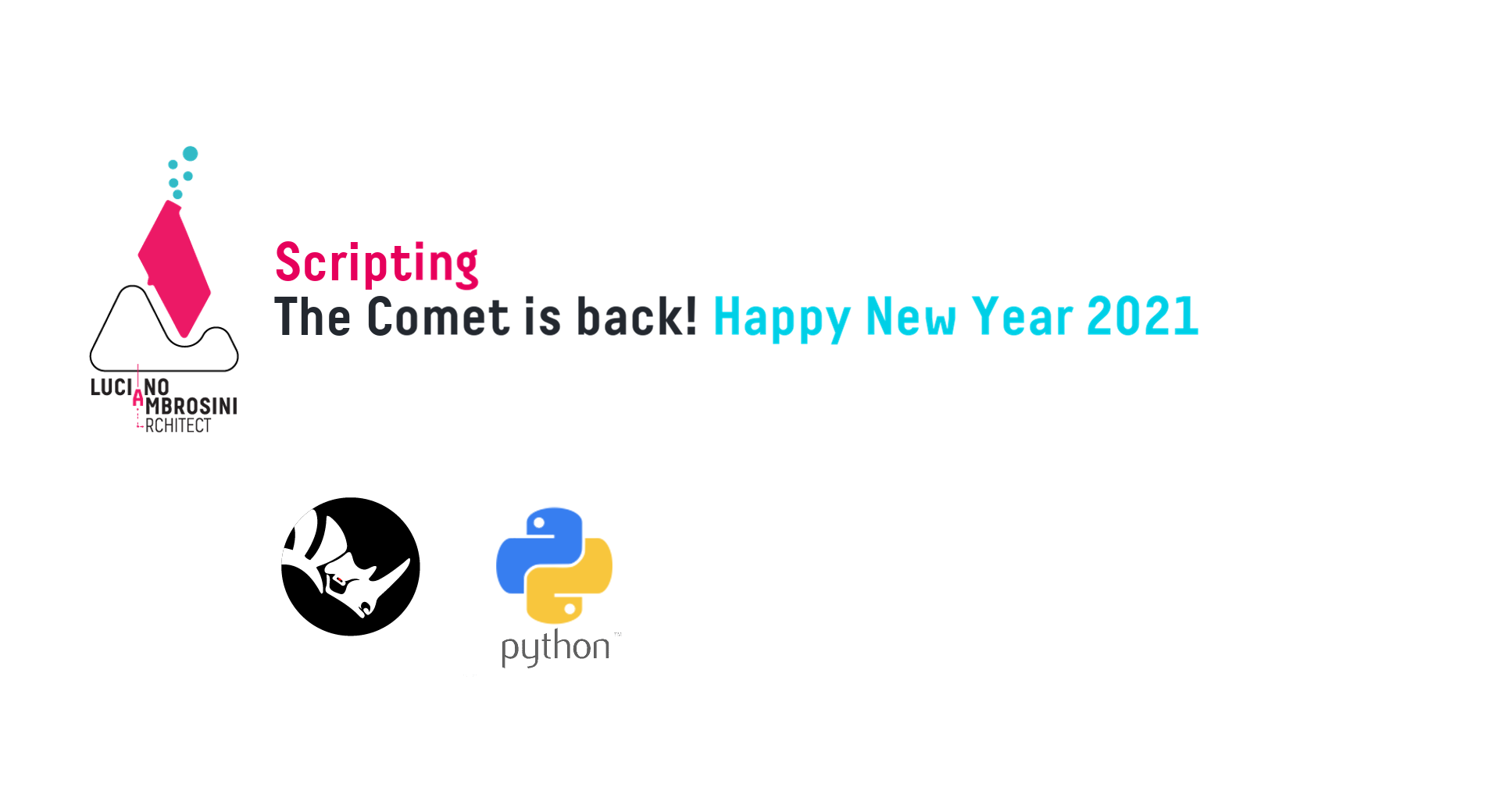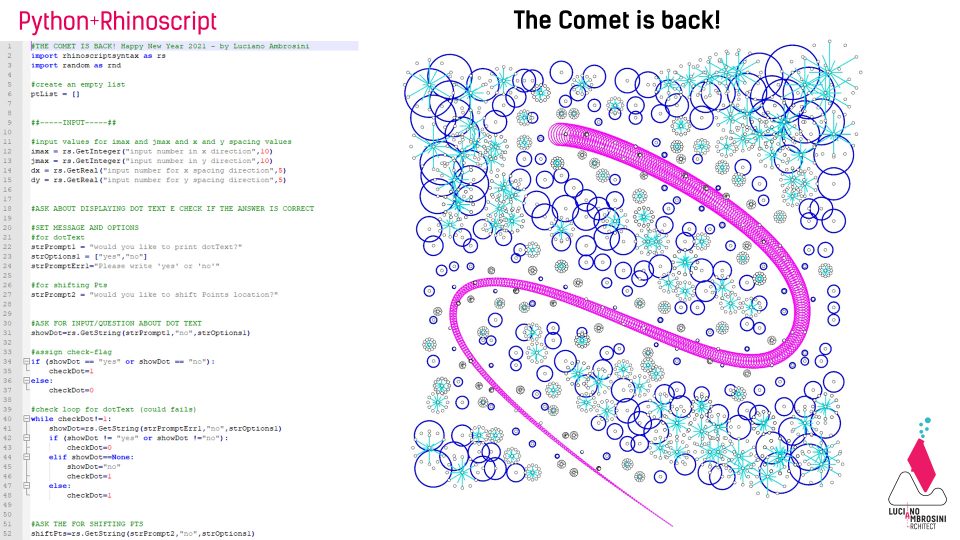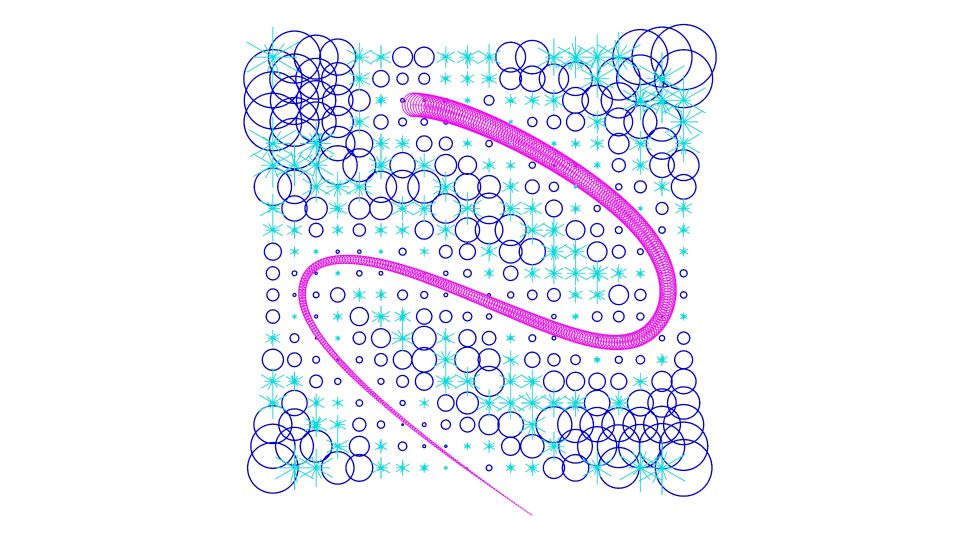Sketching by Rhino ( Python + Rhinoscript). Happy New Year 2021!
Feel free to edit/modify the script below
#THE COMET IS BACK! Happy New Year 2021 - by Luciano Ambrosini import rhinoscriptsyntax as rs import random as rnd #create an empty list ptList = [] ##-----INPUT-----## #input values for imax and jmax and x and y spacing values imax = rs.GetInteger("input number in x direction",10) jmax = rs.GetInteger("input number in y direction",10) dx = rs.GetReal("input number for x spacing direction",5) dy = rs.GetReal("input number for y spacing direction",5) #ASK ABOUT DISPLAYING DOT TEXT E CHECK IF THE ANSWER IS CORRECT #SET MESSAGE AND OPTIONS #for dotText strPrompt1 = "would you like to print dotText?" strOptions1 = ["yes","no"] strPromptErr1="Please write 'yes' or 'no'" #for shifting Pts strPrompt2 = "would you like to shift Points location?" #ASK FOR INPUT/QUESTION ABOUT DOT TEXT showDot=rs.GetString(strPrompt1,"no",strOptions1) #assign check-flag if (showDot == "yes" or showDot == "no"): checkDot=1 else: checkDot=0 #check loop for dotText (could fails) while checkDot!=1: showDot=rs.GetString(strPromptErr1,"no",strOptions1) if (showDot != "yes" or showDot !="no"): checkDot=0 elif showDot==None: showDot="no" checkDot=1 else: checkDot=1 #ASK THE FOR SHIFTING PTS shiftPts=rs.GetString(strPrompt2,"no",strOptions1) #assign check-flag if (shiftPts == "yes" or shiftPts == "no"): checkShift=1 else: checkShift=0 #check loop for shifting Pts while checkShift!=1: shiftPts=rs.GetString(strPromptErr1,"no",strOptions1) if (shiftPts != "yes" or shiftPts !="no"): checkShift=0 elif shiftPts==None: shiftPts="no" checkPts=1 else: checkShift=1 #SELECT ATTRACTOR CURVE attrCrv=rs.GetObject("pick an attractor curve",rs.filter.curve) ##-----TRANSFORMATION-----## #set shifting Pts random values rndSpts=1 rndEpts=5 rndSTpts=1 #nested incremental loop to generate a matrix-points for i in range(imax): for j in range(jmax): if shiftPts=="yes": x = i*dx + (rnd.randrange(rndSpts,rndEpts,rndSTpts,int)) y = j*dy + (rnd.randrange(rndSpts,rndEpts,rndSTpts,int)) z = 0 else: #case: no-shifted Pts x = i*dx y = j*dy z = 0 #draw Pts in Rhino.Space #rs.AddPoint(x,y,z) #print dot texts if showDot=="yes": rs.AddTextDot((x,y,z), (x,y,z)) #save point values in a list ptList.append((x,y,z)) #RETRIEVE MIN-DISTANCE BETWEEN Matrix Pts[i] AND THE ATTRACTOR CURVE #divide attractor curve in N parts Ndiv=imax*jmax #create an array of Pts on attrCrv PtsOnCrv=rs.DivideCurve(attrCrv,Ndiv) PtsCrv=rs.AddPoints(PtsOnCrv) rs.HideObject(PtsCrv) DistFrmCrv=[] #array of pts on attrCrv MinDistFrmCrv=[] #array of min-ditance values for i in range(len(ptList)): for k in range(Ndiv+1): DistFrmCrv.append(rs.Distance(ptList[i], PtsOnCrv[k])) #retrieve min-distance value between matrix points and attractor curve DistFrmCrv.sort() MinDistFrmCrv.append(DistFrmCrv[0]) #print(MinDistFrmCrv[i]) DistFrmCrv*=0 #retrieve min and max of MinDistFrmCrv useful for remapping values minDist=min(MinDistFrmCrv) maxDist=max(MinDistFrmCrv) #print(minDist) #print(maxDist) #draw a circle with scaled-radius ratio=dx/dy sclF=6 Circles=[] #array of drew circles if dx<=dy: Rmax=dx*0.55 Rmin=dy*0.3 else: Rmax=dy*0.55 Rmin=dx*0.3 for i in range(len(ptList)): #remap min distance rmpR=((Rmax-Rmin)/(maxDist-minDist))*MinDistFrmCrv[i] radius=rmpR*sclF #create circle using distance value as radius Circles.append(rs.AddCircle(ptList[i], radius)) #Set Stars parameters maxStars=imax*jmax-1 #max number of stars nLines=12 #stars resolution dfltN=int(maxStars/2) #suitable n stars value rndList = [] Lines=[] nl=int(nLines/3) #number of lines to scale #ask for how many stars you want nStars = rs.GetInteger("How many stars you want?",dfltN) if nStars>maxStars: nStars=maxStars for i in range(nStars): n = rnd.randint(0,maxStars) rndList.append(n) #print(rndList) #draw a star (inner circle-lines) from center (matrix points) to some points on circle for i in range(nStars): rndID=rndList[i] cPts=rs.DivideCurve((Circles[rndID]),nLines) crcPts=rs.AddPoints(cPts) rs.HideObject(crcPts) #not hide to perform better final-7visualization #draw lines for j in range(nLines): XsclStar = round((rnd.uniform(0.25,0.8)),2) #stars scale factors YsclStar = round((rnd.uniform(0.25,0.8)),2) if j%2: Lines.append(rs.AddLine(ptList[rndID],crcPts[j])) else: lin=rs.AddLine(ptList[rndID],crcPts[j]) Lines.append(rs.ScaleObject(lin,ptList[rndID],(XsclStar,YsclStar,1),False)) #hide the circle of the star rs.HideObject(Circles[rndID]) #message box msg=rs.MessageBox("the Comet is coming!", 0 | 32) if msg==1: #POPULATE ATTRACTOR CURVE WITH SCALED CIRCLES #create an array of Pts on attrCrv PtsOnCrv=rs.DivideCurve(attrCrv,Ndiv) PtsCrv=rs.AddPoints(PtsOnCrv) rs.HideObject(PtsCrv) #create circle (the comet) for i in range(Ndiv): radius=Rmax circle=rs.AddCircle(PtsCrv[i], radius) sF=(1/Ndiv)*0.5+(1/Ndiv)*i DefCirc=rs.ScaleObject(circle,PtsCrv[i],(sF,sF,1),False) #Final message box rs.MessageBox("Happy New Year 2021!", 0 | 32)




